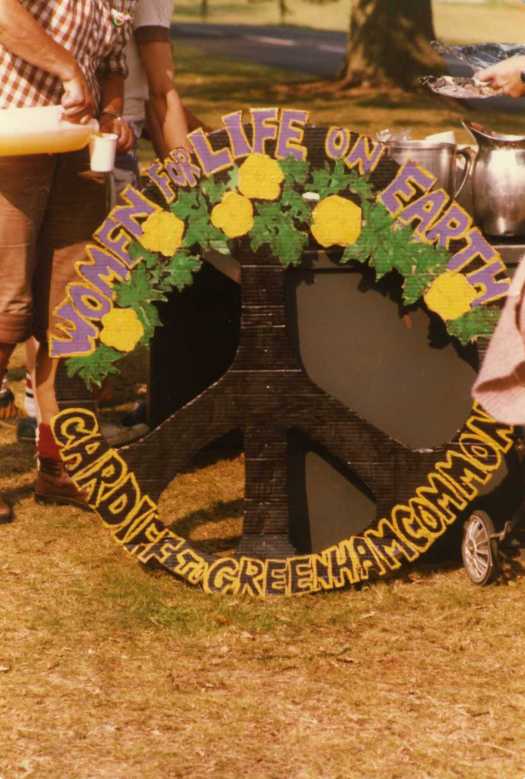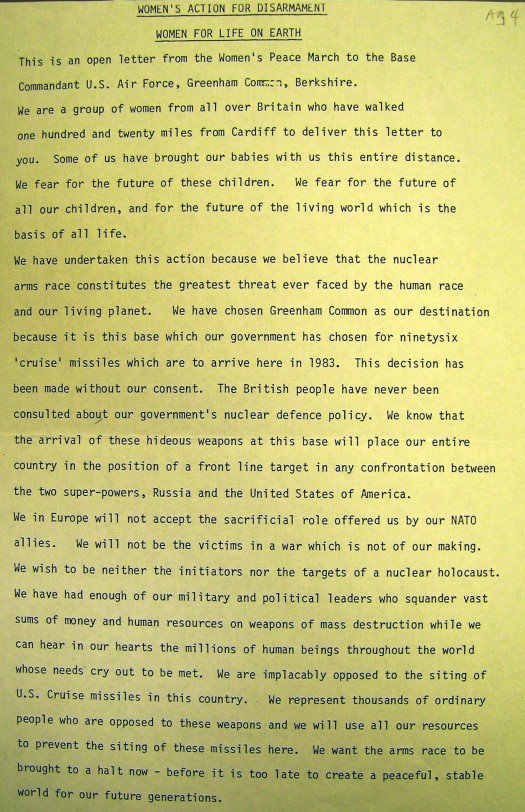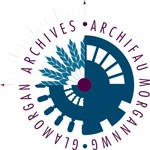In 1986 Glamorgan Archives received a deposit from the peace group ‘Women for Life on Earth’. The collection relates to the women’s peace march from Cardiff to Greenham Common in Berkshire, and the peace camp which was subsequently established outside the main gates of the air base at Greenham Common. The papers cover the period from 1981 to 1984, and consist of correspondence, news cuttings, articles and photographs. The collection is a valuable resource for research into aspects of the women’s movement and of the peace movement. Glamorgan Archives was chosen as the place of deposit because the march started from Cardiff.
The march for peace from Cardiff to Greenham Common was the idea of Ann Pettitt, who, with her husband, ran a smallholding in West Wales, and three other women from the same area. In April 1981 they heard about a group of Scandinavian women who were planning to march from Copenhagen to Paris during the summer of that year, to draw attention to their anxieties about the nuclear threat overshadowing their lives. The group of four in Wales decided to organise a similar march, not from one large city to another, but through smaller places to Greenham Common, at that time a little-known American air base. The march was to last ten days, and cover over 110 miles. Greenham Common was the chosen destination because of the decision to house 96 nuclear cruise missiles at the base, to become operational by December 1983. Cruise missiles are weapons designed to carry nuclear bombs fifteen times as powerful as the one which destroyed Hiroshima. The march was to be a protest against the siting of cruise missiles in Britain.
The four women who organised and co-ordinated the march envisaged a small core group of mainly women and children (35 to 50 in number), who would walk all the way, gathering support en route. Walking, as a form of direct action, was thought to be a simple and old-fashioned way of spreading their message and meeting people to exchange ideas. The message of the march would be a call for disarmament and a plea for a peaceful world. Accommodation and food was arranged for the core group along the route of the march, and local disarmament groups organised meetings with guest speakers and entertainment for the evenings.
Women for Life on Earth was formed in response to the decision to organise the peace march. The motif for the group depicted the world inside the disarmament symbol, sprouting into a tree, to show that the movement was not narrow or particular, but wide and universal. A banner showing this sign was embroidered for the march.

It was decided that women should lead the march and form the nucleus, though men would be welcome as supporters. The march would highlight the fact that women are active and prominent in the peace movement and in the campaign against nuclear weapons. It was felt that the hard work of many women in local disarmaments groups is not reflected in public speeches – women’s voices should be heard and the march would be a platform for them. At the meetings and events along the way, women would be invited to speak.
The organisers thought that most women spend time caring for others, many work in caring professions – they invest their time in people and feel a special responsibility to offer them a future. Many women bear and raise children, and might feel more concerned about the prospect of a nuclear war because of this. Most women have played no part in the decisions which have brought the world to a position where a few hold the lives of all in their control. Women for Life on Earth felt that it was time for women to be heard.
The peace march to Greenham Common started from Cardiff on 27 August 1981.

The core group consisted of about forty women and several children. The women were of all ages, and from very different occupations and backgrounds – from a single mother of five children to a grandmother of four grandchildren. The march left Cardiff and passed the Royal Ordnance factory in Llanishen, where components for nuclear weapons were manufactured. The group then walked through Newport to Chepstow, passing the American arms depot at Caerwent, where stocks of chemical weapons were held. The route then lay through Bristol, Bath, Melksham, Devizes, Marlborough, and Hungerford to Newbury. A detour was made to the US base and tactical nuclear weapons store at Welford. The walkers reached the Greenham Common air base on 5 September.
When they reached their destination the marchers delivered a letter of protest to the base commandant, explaining their action:
We have undertaken this action because we believe that the nuclear arms race constitutes the greatest threat ever faced by the human race and our living planet.

Many of the records held at Glamorgan Archives contain personal recollections of the march. Women from many different backgrounds felt so strongly about the nuclear threat that they left their homes, families, children, and gave up ten days to walk over 110 miles. Many were not used to walking and developed blisters:
The blister on my foot was so big I couldn’t keep my shoe on.
For many women the march was to be their first experience of public protest. For some it was the first time they had left their families to go away alone:
For all of us if was the first time we had ever walked that far.
All seemed to gain a great deal from the experience – while walking they talked and grew close to each other:
We all felt like one family by the end of ten days and were very sad to separate and return to our various lives.
The group varied in number between 35 and 60, as marchers joined or left. Leaflets were distributed along the way, giving reasons for the march, and describing some of the horrors of nuclear war. The core group all wore scarves especially designed for the march, showing the figure of a woman in purple and white, and the peace symbol in green – suffragette colours. These were worn around heads, like cloaks, or even as skirts. The reaction of one woman on joining the march was:
…such an ordinary bunch wearing those funny scarves…
Her feelings had changed by the time they reached the base:
Those speeches, woman after woman … saying so much, so well – how could they ever have seemed ordinary?
The group’s reception in places along the route was warm, except in the large cities, such as Bristol, where only a handful of local people attended to listen to speeches that had been arranged. Volunteers in smaller towns, however, cooked lavish meals and provided excellent accommodation. Meetings and entertainment had been arranged – the folk singers, Peggy Seager and Ewan McColl, appeared at Melksham. There were low points on the march. As the walkers approached Bath, they trudged along silently, feeling very tired. Suddenly, the Fall-Out band jumped out of a van in a layby, music began to be played, and the marchers danced all the way into town. The march was never silent again:
Singing became very important. It raised our spirits and got our message across.
As they drew nearer Greenham Common, the marchers began to worry about the lack of media interest in their protest. On reaching the common, they …walked round the base … excited, nervous, sick, tingly…, expecting to be greeted by a cheering throng. In fact there were not many there to meet them, so feeling down-hearted at the lack of response to their march, a few of the women decided to make a gesture and chained themselves to the fence. The chainings ended the media silence, but the press unfortunately put more emphasis on women in bondage than women for peace. The action was dropped after a few days.
The frustration of being ignored made the peace women even more determined to be noticed. They decided to stay outside the gates of the air base until the government agreed to a televised debate between politicians and ordinary people on the subject of nuclear weapons. The women thought they should have the right to argue their views with a government which had decided to accept U.S. missiles without any public debate.
The government ignored their request, so the women remained and the Greenham Common peace camp became established. For 19 years it acted as a focus for opposition to cruise missiles and all weapons of mass destruction. Although the last of the cruise missiles were withdrawn by the U.S. Air Force in March 1991, women remained at the air base until 2000 to continue their peaceful protest against the nuclear arms race.
The Greenham Common peace camp was the first of its kind in Britain. It became a model for similar camps around the country. Peace camps carried the peace movement to the doorsteps of the military establishment. During 1982 camps were set up at Molesworth, Fairford, Burtonwood, Hexham, Upper Heyford, Burghfield, and Waddington.
Women for Life on Earth organised more peace marches. The Cardiff to Brawdy march took place in May and June 1982. R.A.F. Brawdy in Pembrokeshire included an American tracking station, which was thought to be a prime target for a nuclear attack on Britain. In the summer of 1983 women walked from various parts of Britain to converge on Greenham Common on Hiroshima day. Because groups left different areas to meet at a central point, the protest was called the ‘Star’ marches. Groups set off from such places as Barrow, Bath, Cardiff, Merseyside, and the Isle of Wight. A rally and a deliberate blockade of Greenham Common air base took place when the marchers arrived.
The 1981 march from Cardiff to Greenham Common was an important event in the history of the peace movement. Greenham Common peace camp grew out of the march, and a network grew from the peace camp, which included other peace camps. Some of these later developments have been documented in this collection. Glamorgan Archives is fortunate to have received the papers relating to the original march. We would welcome any material of a similar nature. Such information is all too easily lost, unless care is taken for its permanent preservation. It can then become a valuable resource for the historians of the future.

Thank you so much for archiving this.